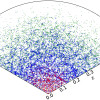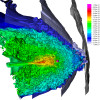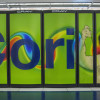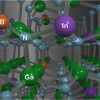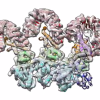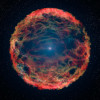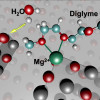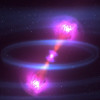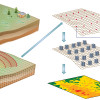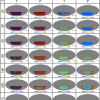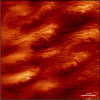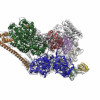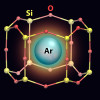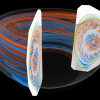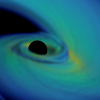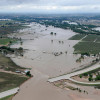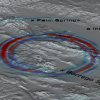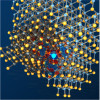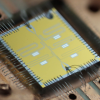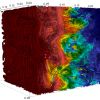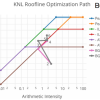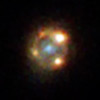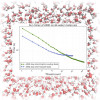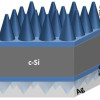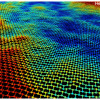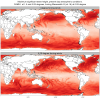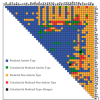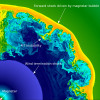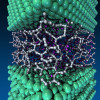Science News
Creating a World of Make-Believe to Better Understand the Real Universe
Seeing is believing, or so the saying goes.And in some cases, a world of make-believe can help you realize what you’re actually seeing, too.Scientists are creating simulated universes, for example – complete with dark matter mock-ups, computer-generated galaxies, quasi quasars, and pseudo supernovae – to better understand real-world observations.Their aim is to envision how new Earth-based and space-based sky surveys will see the universe, and to help analyze and interpret the vast… Read More »
Heavy Metal: How First Supernovae Altered Early Star Formation
An international team of researchers ran multi-scale, multi-physics 2D and 3D simulations at NERSC to illustrate how heavy metals expelled from exploding supernovae helped the first stars in the universe regulate subsequent star formation and influence the appearance of galaxies in the process. Read More »
High-Performance Computing Cuts Particle Collision Data Prep Time
For the first time, scientists have used high-performance computing to reconstruct the data collected by a nuclear physics experiment—an advance that could dramatically reduce the time it takes to make detailed data available for scientific discoveries. Read More »
NERSC Resources Help Predict New Material for High-Power, High-Efficiency LEDs
Using predictive atomistic calculations and high-performance supercomputers at NERSC, University of Michigan researchers found that incorporating the element boron into the widely used InGaN (indium-gallium nitride) material can keep electrons from becoming too crowded in LEDs, making the material more efficient at producing light. Read More »
Detailed View of Immune Proteins Could Lead to New Pathogen-Defense Strategies
Researchers at Berkeley Lab and UC Berkeley used cryo-electron microscopy to capture a high-resolution image of a protein ring called an “inflammasome” as it was bound to flagellin, providing new insight into potential strategies for protection from pathogens. Read More »
Deep Learning for Science: A Q&A with NERSC’s Prabhat
In this Q&A with Prabhat, who leads the Data and Analytics Services Group at NERSC and has been instrumental in several projects exploring opportunities for deep learning in science, he talks about the history of deep learning and machine learning and the unique challenges of applying these data analytics tools to science. Read More »
The Mystery of the Star That Wouldn’t Die
Supercomputers at NERSC helped an international team of scientists decipher one of the most bizarre spectacles ever seen in the night sky: A supernova that refused to stop shining, remaining bright far longer than an ordinary stellar explosion. What caused the event is puzzling. Read More »
Solving a Magnesium Mystery in Rechargeable Battery Performance
Simulations run at NERSC helped a research team at the Joint Center for Energy Storage Research discover a surprising set of chemical reactions involving magnesium that degrade battery performance even before the battery can be charged up. Read More »
Scientists Decode the Origin of Universe’s Heavy Elements in the Light from a Neutron Star Merger
Scientists have obtained the first measurement of the merger of two neutron stars and its explosive aftermath. Computer simulations at NERSC were critical for understanding the event, which could provide valuable insights into the origin of universe’s heavy elements. Read More »
Assessing Regional Earthquake Risk and Hazards in the Age of Exascale
Researchers from Berkeley Lab, Lawrence Livermore Lab and UC Davis are using supercomputers at NERSC to build the first-ever end-to-end simulation code to precisely capture the geology and physics of regional earthquakes, and how the shaking impacts buildings. Read More »
A TOAST for Next Generation CMB Experiments
Computational cosmologists at Berkeley Lab they recently achieved a critical milestone in preparation for upcoming CMB experiments: scaling their data simulation and reduction framework TOAST to run on all 658,784 Intel Knights Landing Xeon Phi processor cores on the NERSC’s Cori. The team also implemented a new TOAST module to simulate the noise introduced when ground-based telescopes look at the CMB through the atmosphere. Read More »
Multiscale Simulations Help Predict Unruly Plasma Behavior
New multiscale gyrokinetic simulations are making it easier to more accurately predict plasma behavior in a tokamak reactor. Read More »
NERSC Supercomputers Help Berkeley Lab Scientists Map Key DNA Protein Complex
Using cryo-electron microscopy and supercomputing resources at NERSC, Berkeley Lab scientists have obtained 3-D models of a human transcription factor at near-atomic resolutions. Read More »
A First: Trapping Noble Gases in 2D Porous Structures at Room Temp
A materials science breakthrough at the nanoscale could lead to better methods for capturing noble gases, such as radioactive krypton and xenon generated by nuclear power plants. Read More »
Simulations Show How Recycled Atoms Boost Plasma Turbulence
Using NERSC's Edison supercomputer, physicists at Princeton Plasma Physics Laboratory have modeled how recycled neutral atoms, which arise when hot plasma strikes a tokamak fusion reactor’s walls, increase plasma turbulence driven by what is called the “ion temperature gradient.” Read More »
New Simulations Could Help in Hunt for Massive Mergers of Neutron Stars, Black Holes
Working with an international team, Berkeley Lab scientists have developed new computer models to explore what happens when a black hole joins with a neutron star – the superdense remnant of an exploded star. Read More »
'Hindcasting' Study Investigates the Extreme 2013 Colorado Flood
Using a publicly available climate model, Berkeley Lab researchers “hindcast” the conditions that led to the Sept. 9-16, 2013 flooding around Boulder, Colo. and found that climate change attributed to human activity made the storm much more severe than would otherwise have occurred. Read More »
Record-setting Seismic Simulations Run on NERSC’s Cori System
Record-setting seismic simulations run earlier this year on the Cori supercomputer at NERSC were the subject of two presentations at the ISC High Performance conference in Frankfurt, Germany this week. Read More »
Simulations Pinpoint Atomic-level Defects in Solar Cell Nanostructures
Heterogeneous nanostructured materials are widely used in various optoelectronic devices, including solar cells. However, the nano-interfaces contain structural defects that can affect the performance of optoelectronic devices. Running calculations at NERSC, researchers found the root cause of the defects in two materials and provided design rules to avoid them. Read More »
Record-breaking 45-qubit Quantum Computing Simulation Run at NERSC on Cori
Researchers from ETH Zurich in Switzerland used the Cori supercomputer at NERSC to simulate a 45-qubit circuit, the largest simulation of a quantum computer ever achieved. Read More »
HPC4Mfg Paper Manufacturing Project Yields First Results
Simulations run at NERSC as part of a unique collaboration comprising Berkeley Lab, Lawrence Livermore National Laboratory and an industry consortium could help U.S. paper manufacturers significantly reduce production costs and increase energy efficiencies. Read More »
Roofline Model Boosts Manycore Code Optimization Efforts
A software toolkit developed in Berkeley Lab's Computational Research Division to better understand supercomputer performance is now being used to boost application performance for researchers running codes at NERSC and other supercomputing facilities. Read More »
Rare Supernova Discovery Ushers in New Era for Cosmology
With the help of an automated supernova-hunting pipeline based at NERSC, astronomers have captured multiple images of a gravitationally lensed Type 1a supernova and its host galaxy. This detection is currently the only one of its kind, but astronomers believe that if they can find more they may be able to measure the rate of the Universe’s expansion within four percent accuracy. Read More »
Berkeley Lab Researchers Make NWChem’s Planewave “Purr” on Intel’s Knights Landing Architectures
Berkeley Lab researchers have successfully added thread-level parallelism on top of MPI-level parallelism in the planewave density functional theory method within the popular software suite NWChem. An important step to ensuring that computational chemists are prepared to compute efficiently on next-generation exascale machines. Read More »
Towards Super-Efficient, Ultra-Thin Silicon Solar Cells
Ames Laboratory researchers are developing a highly absorbing ultra-thin crystalline silicon solar cell architecture with enhanced light-trapping capabilities. Read More »
Machine Learning Algorithms Enhance Predictive Modeling of 2D Materials
Researchers from Argonne National Laboratory, using supercomputers at NERSC, are employing machine learning algorithms to accurately predict the physical, chemical and mechanical properties of nanomaterials, reducing the time it takes to yield such predictions from years to months—in some cases even weeks. Read More »
Researchers Catch Extreme Waves with High-Resolution Modeling
Using decades of global climate data generated at a spatial resolution of about 25 kilometers squared, Berkeley Lab researchers were able to capture the formation of tropical cyclones, also referred to as hurricanes and typhoons, and the extreme waves that they generate. Read More »
Machine Learning Accurately Predicts Metallic Defects
Using NERSC supercomputers, Berkeley Lab researchers built and trained machine learning algorithms to predict defect behavior in certain intermetallic compounds with high accuracy. This method will accelerate research of new advanced alloys and lightweight new materials for applications spanning automotive to aerospace and much more. Read More »
Simulations Reveal Invisible Chaos of Superluminous Supernovae
To better understand the physical conditions that create superluminious supernova, astrophysicists are running 2D simulations of these events using supercomputers at NERSC and the Lawrence Berkeley National Laboratory (Berkeley Lab) developed CASTRO code. Read More »
Diamond Shines in Molecular Dynamics Simulations
For centuries diamonds have been revered for their strength, beauty, value and utility. Now a team of researchers from Argonne National Laboratory, running molecular dynamics calculations at the Argonne Leadership Computing Facility and NERSC, are finding additional reasons to celebrate this complex material—and it has nothing to do with color, cut or clarity. Read More »






